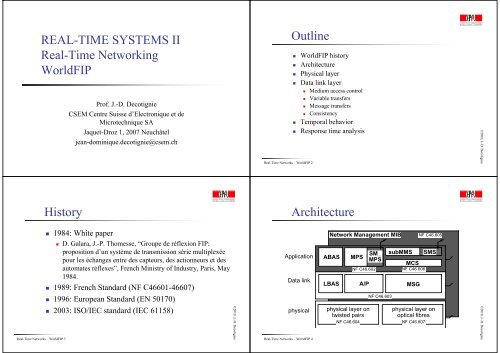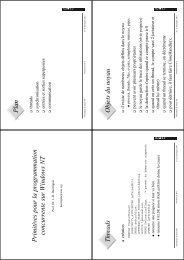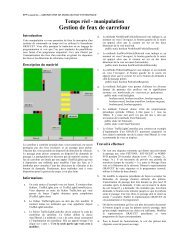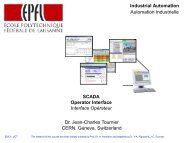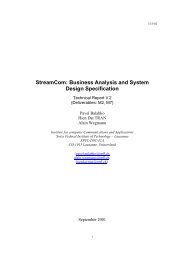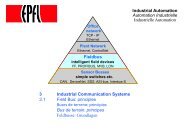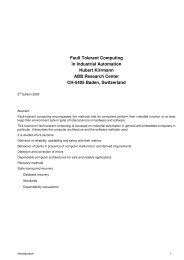REAL-TIME SYSTEMS II Real-Time Networking WorldFIP ... - EPFL
REAL-TIME SYSTEMS II Real-Time Networking WorldFIP ... - EPFL
REAL-TIME SYSTEMS II Real-Time Networking WorldFIP ... - EPFL
You also want an ePaper? Increase the reach of your titles
YUMPU automatically turns print PDFs into web optimized ePapers that Google loves.
<strong>REAL</strong>-<strong>TIME</strong> <strong>SYSTEMS</strong> <strong>II</strong><br />
<strong>Real</strong>-<strong>Time</strong> <strong>Networking</strong><br />
<strong>WorldFIP</strong><br />
Prof. J.-D. Decotignie<br />
CSEM Centre Suisse d’Electronique et de<br />
Microtechnique SA<br />
Jaquet-Droz 1, 2007 Neuchâtel<br />
jean-dominique.decotignie@csem.ch<br />
Outline<br />
<strong>Real</strong>-<strong>Time</strong> Networks – <strong>WorldFIP</strong> 2<br />
• <strong>WorldFIP</strong> history<br />
• Architecture<br />
• Physical layer<br />
• Data link layer<br />
• Medium access control<br />
• Variable transfers<br />
• Message transfers<br />
• Consistency<br />
• Temporal behavior<br />
• Response time analysis<br />
©2010, J.-D. Decotignie<br />
History<br />
Architecture<br />
<strong>Real</strong>-<strong>Time</strong> Networks – <strong>WorldFIP</strong> 3<br />
• 1984: White paper<br />
• D. Galara, J.-P. Thomesse, “Groupe de réflexion FIP:<br />
proposition d’un système de transmission série multiplexée<br />
pour les échanges entre des capteurs, des actionneurs et des<br />
automates réflexes”, French Ministry of Industry, Paris, May<br />
1984.<br />
• 1989: French Standard (NF C46601-46607)<br />
• 1996: European Standard (EN 50170)<br />
• 2003: ISO/IEC standard (IEC 61158)<br />
©2010, J.-D. Decotignie<br />
Application<br />
Data link<br />
physical<br />
<strong>Real</strong>-<strong>Time</strong> Networks – <strong>WorldFIP</strong> 4<br />
Network Management MIB<br />
ABAS MPS SM_<br />
MPS<br />
subMMS<br />
MCS<br />
LBAS A/P MSG<br />
physical layer on<br />
twisted pairs<br />
NF C46.602 NF C46.606<br />
NF C46.603<br />
SMS<br />
physical layer on<br />
optical fibres<br />
NF C46.604 NF C46.607<br />
NF C46.605<br />
©2010, J.-D. Decotignie
Basic Choices<br />
Basic Choices (2)<br />
<strong>Real</strong>-<strong>Time</strong> Networks – <strong>WorldFIP</strong> 5<br />
• <strong>Real</strong>-time traffic consists of state information transferred in a<br />
cyclic or periodic manner but not event transmission<br />
• All information is broadcast<br />
• For real-time traffic,<br />
• only variables are identified (identifiers). Network nodes or application<br />
processes are not identified<br />
• the communication model is the Producer-Distributor-Consumer (PDC)<br />
Model where variable values transferred on the network are neither<br />
queued at production nor at reception<br />
• There is no retransmission and no acknowledge for real-time traffic<br />
• Consumers are responsible for checking transmission status and taking<br />
appropriate actions when problems arise<br />
©2010, J.-D. Decotignie<br />
<strong>Real</strong>-<strong>Time</strong> Networks – <strong>WorldFIP</strong> 6<br />
• All variables transferred in real-time and their characteristics<br />
(period, relation with other transfers) are known in advance<br />
• MAC handled by a unique active distributor. Backup allowed<br />
• The response time is bounded between 10 and 70 bit times.<br />
• Transfers are either periodic or sporadic.<br />
• The transfer period for the values corresponding to a variable may differ<br />
from the period associated to another variable. The only restriction is that<br />
periods should be integer multiples of a basic period.<br />
• Mechanisms to indicate temporal validity as well as temporal<br />
and spatial consistency of variable values built in the protocol.<br />
• The non real-time traffic handled using the conventional clientserver<br />
model and the corresponding application is a subset of<br />
MMS (Manufacturing Message Specification).<br />
©2010, J.-D. Decotignie<br />
Physical layer<br />
Coding<br />
<strong>Real</strong>-<strong>Time</strong> Networks – <strong>WorldFIP</strong> 7<br />
• twisted pairs (C46-604), optical fibers (C46-607)<br />
• 3 speed classes<br />
• S1 (31.25 Kbits/s) / S2 (1 Mbits/s) / S3 (2.5 Mbits/s)<br />
• Number of elements and range limited by<br />
• Propagation time Tp<br />
• normal case: Tp < 20 Tbit / extended: Tp < 40 Tbit<br />
• Losses and distortion on the cable<br />
• 3 conformance classes<br />
• CH: high level class, allows long distance transmission at high data rates<br />
• CM: medium power class<br />
• CL: low power class for application with intrinsic safety requirements.<br />
• recommended speeds<br />
• S1 or S2 for CL, S2 for CM, S2 or S3 for CH<br />
©2010, J.-D. Decotignie<br />
<strong>Real</strong>-<strong>Time</strong> Networks – <strong>WorldFIP</strong> 8<br />
• balanced (bipolar) transmission<br />
• MANCHESTER encoding<br />
-T/2<br />
H<br />
T/2 -T/2<br />
B<br />
T/2<br />
H<br />
-T/2 T/2<br />
-T/2 T/2<br />
B<br />
-T/2<br />
H<br />
T/2 -T/2<br />
1 0 V+ V- EB+ EB-<br />
Data Violations equalization bits<br />
B<br />
T/2<br />
©2010, J.-D. Decotignie
Optical physical layer<br />
Topology using optical fibers<br />
<strong>Real</strong>-<strong>Time</strong> Networks – <strong>WorldFIP</strong> 9<br />
• identical to twisted pair one for:<br />
• Services, coding and transmission speeds<br />
• restricted topology by exclusive use of active optical<br />
stars and point to point links<br />
TSG1<br />
TR1<br />
• ⇒ special confirmation signal<br />
between 2 stars<br />
• amplitude modulation of the TSG5<br />
optical signal (H symbol at<br />
higher level than B symbol)<br />
AOS<br />
TSG4<br />
TSG2<br />
TR2<br />
TR3<br />
TSG3<br />
©2010, J.-D. Decotignie<br />
<strong>Real</strong>-<strong>Time</strong> Networks – <strong>WorldFIP</strong> 10<br />
active optical<br />
star<br />
subscriber<br />
elementary<br />
optical<br />
link<br />
©2010, J.-D. Decotignie<br />
Data Link Layer<br />
Addressing<br />
<strong>Real</strong>-<strong>Time</strong> Networks – <strong>WorldFIP</strong> 11<br />
• makes use of cyclic nature of exchanges<br />
• nearly systematic use of broadcast<br />
• centralized medium access control (bus arbiter)<br />
• 2 types data transfer services<br />
• services used for variable transfers<br />
• services for message transfers<br />
• 2 transfer types<br />
• on request<br />
• cyclic (triggered by the bus arbiter)<br />
• seems a distributed shared memory<br />
Application<br />
processs 1<br />
Application<br />
processs n<br />
Application<br />
processs 2<br />
Application<br />
processs k<br />
Application<br />
processs 3<br />
©2010, J.-D. Decotignie<br />
<strong>Real</strong>-<strong>Time</strong> Networks – <strong>WorldFIP</strong> 12<br />
• 2 different addressing spaces<br />
• For variables<br />
• identified by a unique identifier (16 bits) for each variable<br />
• address is not related to physical location<br />
• each variable producer and consumer(s) know the identifier of the<br />
variable<br />
• For messages<br />
• bear a source and a destination address (24 bits)<br />
• address is divided into a segment number (8 bits) and a LSAP (16<br />
bits)<br />
©2010, J.-D. Decotignie
Variable transfers<br />
Message transfers<br />
<strong>Real</strong>-<strong>Time</strong> Networks – <strong>WorldFIP</strong> 13<br />
• the DLL associates<br />
• a buffer (B_DATprod) to each identifier of produced<br />
variable<br />
• a buffer (B_DATcons) to each identifier of consumed<br />
variable<br />
PRODUCER DLL BUS DLL CONSUMERS<br />
L_PUT.req<br />
L_PUT.cnf<br />
B_DAT<br />
prod<br />
ID<br />
B_DAT<br />
cons<br />
ID<br />
L_GET.req<br />
L_GET.cnf<br />
©2010, J.-D. Decotignie<br />
SOURCE<br />
L_MESSAGE.<br />
request<br />
L_MESSAGE.<br />
confirmation<br />
<strong>Real</strong>-<strong>Time</strong> Networks – <strong>WorldFIP</strong> 14<br />
• the DLL associates<br />
• a queue (F_MSG) for the messages it needs to send<br />
• a queue (F_MSGreçu) for the messages that it receives<br />
DLL<br />
F_MSG<br />
DLL<br />
F_MSG<br />
reçu<br />
DESTINATION<br />
L_MESSAGE.<br />
indication<br />
©2010, J.-D. Decotignie<br />
Behavior<br />
Medium access control<br />
• variables<br />
<strong>Real</strong>-<strong>Time</strong> Networks – <strong>WorldFIP</strong> 15<br />
• writing (reading) a variable does not trigger directly any<br />
traffic on the network<br />
• a new write operation overwrites the previous variable value<br />
• reception and emission of a value is signaled<br />
• → flow control possible (not necessary)<br />
• messages<br />
• stored in a queue → no overwrite<br />
• transfer is signaled → flow control<br />
• duplications are avoided using alternating bit protocol<br />
©2010, J.-D. Decotignie<br />
Stage 1: BA broadcast identifier<br />
BA<br />
D D D D D<br />
Stage 3: producer broadcasts data<br />
BA<br />
D P D C C<br />
<strong>Real</strong>-<strong>Time</strong> Networks – <strong>WorldFIP</strong> 16<br />
BA<br />
Stage 2: the producer and all<br />
consumers recognize the ID<br />
D P D C C<br />
Stage 4: all consumers acquire data<br />
BA<br />
D D D C C<br />
©2010, J.-D. Decotignie
Bus Arbiter (BA)<br />
Signalling a request<br />
<strong>Real</strong>-<strong>Time</strong> Networks – <strong>WorldFIP</strong> 17<br />
• control medium access<br />
• a single one is active, however several may be in<br />
backup<br />
• triggers all transactions<br />
• cyclic variable and message transfers<br />
• decided at configuration<br />
• configuration may be changed at run time<br />
• on-request variable and message transfers<br />
As a station may not emit without being invited to,<br />
each station must possess a mean to inform<br />
the Bus Arbiter that it requests a transfer<br />
©2010, J.-D. Decotignie<br />
<strong>Real</strong>-<strong>Time</strong> Networks – <strong>WorldFIP</strong> 18<br />
• uses the periodic transfer of variables<br />
• in its response to a periodic variable transfer invitation<br />
(from the Bus Arbiter), the producer DLL will<br />
indicate its request<br />
a station that does not produce any periodic variable<br />
cannot explicitly require the transfer of a variable or a message<br />
• ⇒ message transfers are related to a variable identifier<br />
• BA will later poll the requesting station to get the list<br />
of identifiers of the variables or messages for which a<br />
transfer is requested<br />
©2010, J.-D. Decotignie<br />
Operating principle<br />
Read / write buffer services<br />
<strong>Real</strong>-<strong>Time</strong> Networks – <strong>WorldFIP</strong> 19<br />
• according to configuration and explicit requests, the<br />
BA will establish a polling order<br />
periodic window<br />
(variables + messages)<br />
aperiodic window<br />
(variable exchanges)<br />
elementary poll cycle<br />
aperiodic window<br />
(message transfers)<br />
synchronization<br />
window<br />
• the duration of the elementary polling cycle<br />
• is often constant (sampled data systems)<br />
• cannot exceed the duration of the smallest polling period<br />
requested by the users at configuration<br />
©2010, J.-D. Decotignie<br />
<strong>Real</strong>-<strong>Time</strong> Networks – <strong>WorldFIP</strong> 20<br />
• L_PUT/GET.request(identifier, value)<br />
• L_PUT/GET.confirmation(identifier, status)<br />
• status gives the result:<br />
• result OK, unknown identifier, identifier invalidated by Network<br />
management, buffer access conflict, data length non compatible with<br />
buffer<br />
PRODUCER<br />
L_PUT.req<br />
L_PUT.cnf<br />
DLL<br />
B_DAT<br />
prod<br />
ID<br />
BUS<br />
DLL<br />
B_DAT<br />
cons<br />
ID<br />
CONSUMERS<br />
L_GET.req<br />
L_GET.cnf<br />
©2010, J.-D. Decotignie
Buffer transfers<br />
Explicit buffer transfer requests<br />
• 2 data units<br />
ID_DAT IDENTIFIER FCS RP_DAT<br />
VARIABLE<br />
VALUE<br />
FCS<br />
• request signaled when responding to a periodic buffer<br />
transfer request (ID_DAT)<br />
• 2 types<br />
• specified explicit request (identifier specified by DLL user)<br />
PRODUCER<br />
DLL BUS ARBITER DLL CONSUMERS<br />
• free explicit request (identifier chosen by DLL)<br />
L_SENT.ind<br />
<strong>Real</strong>-<strong>Time</strong> Networks – <strong>WorldFIP</strong> 21<br />
B_DAT<br />
prod<br />
IDn<br />
ID_DAT IDn<br />
RP_DAT<br />
B_DAT<br />
cons<br />
IDn<br />
L_RECEIVED.ind<br />
©2010, J.-D. Decotignie<br />
<strong>Real</strong>-<strong>Time</strong> Networks – <strong>WorldFIP</strong> 22<br />
• requester may be neither producer nor consumer of the<br />
variable<br />
• the same identifier may not be used for both types of<br />
requests. It must be configured for a type of service<br />
©2010, J.-D. Decotignie<br />
Explicit buffer transfer requests (2)<br />
Explicit transfer requests<br />
<strong>Real</strong>-<strong>Time</strong> Networks – <strong>WorldFIP</strong> 23<br />
• BA later polls the requesting node for the list of<br />
identifiers of variables and messages for which a<br />
transfer is requested<br />
• BA establishes a list of pollings (ID_MSG or<br />
ID_DAT) to fulfill the requests<br />
• If the same ID is requested while already requested, only one<br />
request is assumed<br />
©2010, J.-D. Decotignie<br />
<strong>Real</strong>-<strong>Time</strong> Networks – <strong>WorldFIP</strong> 24<br />
• specified explicit request<br />
• requests are not queued inside DLL (buffer B_REQ)<br />
• and are served either<br />
• immediately in the periodic window (RQ_INHIBE true)<br />
• or in an aperiodic window (RQ_INHIBE false) with urgent priority<br />
• free explicit request<br />
• requests are queued (file F_REQi) according to priority (i=1<br />
or 2)<br />
• are served according to the priority (1: urgent or 2: normal)<br />
in an aperiodic window<br />
©2010, J.-D. Decotignie
Specified explicit request<br />
(RQ_Inhibe false)<br />
Specified explicit request<br />
(RQ_Inhibe true)<br />
INITIATOR<br />
DLL<br />
BUS ARBITER<br />
DLL<br />
PRODUCER/<br />
CONSUMER(S)<br />
INITIATOR<br />
DLL<br />
BUS ARBITER<br />
DLL<br />
PRODUCER/<br />
CONSUMER(S)<br />
L_SPEC_UPDATE.<br />
request (n)<br />
RQ<br />
ID=n<br />
ID_DAT n<br />
L_SPEC_UPDATE.<br />
request (n)<br />
RQ<br />
ID=n<br />
ID_DAT n<br />
L_SENT.indication<br />
L_SPEC_UPDATE.<br />
confirmation (n)<br />
B_DAT<br />
prod<br />
B_REQ<br />
RP_DAT_RQ1<br />
ID_RQ1 n<br />
RP_RQ1(a,...)<br />
L_SENT.indication<br />
L_SPEC_UPDATE.<br />
confirmation (n)<br />
B_DAT<br />
prod<br />
B_REQ<br />
RP_DAT<br />
ID_RQ1 n<br />
RP_RQ1(a,...)<br />
PRODUCER a<br />
DLL<br />
BUS ARBITER<br />
DLL<br />
CONSUMER(S) a<br />
PRODUCER a<br />
DLL<br />
BUS ARBITER<br />
DLL<br />
CONSUMER(S) a<br />
<strong>Real</strong>-<strong>Time</strong> Networks – <strong>WorldFIP</strong> 25<br />
L_SENT.indication<br />
B_DAT<br />
prod<br />
ID=a<br />
ID_DAT a<br />
RP_DAT<br />
B_DAT<br />
cons<br />
ID=a<br />
L_RECEIVED.indication<br />
©2010, J.-D. Decotignie<br />
<strong>Real</strong>-<strong>Time</strong> Networks – <strong>WorldFIP</strong> 26<br />
L_SENT.indication<br />
B_DAT<br />
prod<br />
ID=a<br />
ID_DAT a<br />
RP_DAT<br />
B_DAT<br />
cons<br />
ID=a<br />
L_RECEIVED.indication<br />
©2010, J.-D. Decotignie<br />
Free explicit requests<br />
Message transfer services<br />
INITIATOR<br />
L_FREE_UPDATE.<br />
request<br />
L_SENT.indication<br />
DLL<br />
ID=n<br />
B_DAT<br />
prod<br />
RQ<br />
BUS ARBITER<br />
ID_DAT n<br />
RP_DAT_RQx<br />
DLL<br />
PRODUCER/<br />
CONSUMER(S)<br />
• with (point to point only) or without acknowledge (protection<br />
against loss and duplication by alternating bit)<br />
• requests are served in<br />
• the periodic window (cyclic msg transfers)<br />
L_FREE_UPDATE.<br />
confirmation<br />
ID=n<br />
F_REQx<br />
ID_RQx n<br />
RP_RQx(a,...)<br />
• → resources allocated at configuration<br />
• the aperiodic window (aperiodic message transfers)<br />
• → requests queued in file F_MSGaper<br />
PRODUCER a<br />
DLL<br />
BUS ARBITER<br />
DLL<br />
CONSUMER(S) a<br />
• multisegment transfers<br />
• only point to point<br />
<strong>Real</strong>-<strong>Time</strong> Networks – <strong>WorldFIP</strong> 27<br />
L_SENT.indication<br />
B_DAT<br />
prod<br />
ID=a<br />
ID_DAT a<br />
RP_DAT<br />
B_DAT<br />
cons<br />
ID=a<br />
L_RECEIVED.indication<br />
©2010, J.-D. Decotignie<br />
<strong>Real</strong>-<strong>Time</strong> Networks – <strong>WorldFIP</strong> 28<br />
• go through a bridge (ack sent by bridge)<br />
©2010, J.-D. Decotignie
Cyclic message transfers<br />
Cyclic message transfers (2)<br />
<strong>Real</strong>-<strong>Time</strong> Networks – <strong>WorldFIP</strong> 29<br />
• use one or more variable identifiers configured for this<br />
type of transfer. The same Ids may be used for buffer<br />
transfer.<br />
• a file (queue F_MSGcyc) is associated to each<br />
identifier<br />
• messages stored in the F_MSGcyc queue associated to<br />
the identifier indicated in the request<br />
• request served in the periodic window (even if no msg<br />
pending)<br />
• transfer is performed with or without ack<br />
©2010, J.-D. Decotignie<br />
SOURCE<br />
L_MESSAGE_ACK.<br />
request<br />
L_SENT.indication<br />
L_MESSAGE_ACK.<br />
confirmation<br />
<strong>Real</strong>-<strong>Time</strong> Networks – <strong>WorldFIP</strong> 30<br />
DLL<br />
ID=n<br />
B_DAT<br />
prod<br />
MSG<br />
ID=n<br />
F_MSG<br />
cyc<br />
BUS ARBITER<br />
ID_DAT n<br />
RP_DAT<br />
ID_MSG n<br />
RP_MSG_ACK<br />
RP_ACK<br />
RP_FIN<br />
DLL<br />
F_MSG<br />
reçu<br />
DESTINATION<br />
L_MESSAGE_ACK.<br />
indication<br />
©2010, J.-D. Decotignie<br />
Aperiodic message transfers<br />
Aperiodic message transfer<br />
• no identifier is indicated in the request<br />
<strong>Real</strong>-<strong>Time</strong> Networks – <strong>WorldFIP</strong> 31<br />
• identifier is chosen by the DLL<br />
• it must be configured for this type of service<br />
• it must correspond to a variable produced by the given station(source of<br />
message)<br />
• it must be already associated to a message in the queue<br />
• the request is signaled to the bus arbiter in the response to an<br />
ID_DAT frame with the selected identifier<br />
• association with the identifier is cut when the message has been<br />
transferred. The ID may then be used for another message in the<br />
queue<br />
©2010, J.-D. Decotignie<br />
SOURCE<br />
L_MESSAGE.<br />
request<br />
L_SENT.indication<br />
L_MESSAGE.<br />
confirmation<br />
<strong>Real</strong>-<strong>Time</strong> Networks – <strong>WorldFIP</strong> 32<br />
DLL<br />
ID=n<br />
B_DAT<br />
prod<br />
MSG<br />
Réf<br />
F_MSG<br />
apér<br />
BUS ARBITER<br />
ID_DAT n<br />
RP_DAT_MSG<br />
ID_MSG n<br />
RP_MSG_NOACK<br />
RP_FIN<br />
DLL<br />
F_MSG<br />
reçu<br />
DESTINATION(S)<br />
L_MESSAGE.<br />
indication<br />
©2010, J.-D. Decotignie
Frame Format<br />
<strong>Time</strong>rs<br />
<strong>Real</strong>-<strong>Time</strong> Networks – <strong>WorldFIP</strong> 33<br />
• PRE = 8 consecutive "1"<br />
• FSD = V+ V- V+ 1 V-<br />
• FED = V- V+ V- 0 V+<br />
• FCS= CRC 16 (CCITT V41) on CD field<br />
Frame Type<br />
identifier (ID_xyz)<br />
Response request (RP_RQx)<br />
Response message (RP_MSG)<br />
Response data (RP_DAT_z)<br />
Other frames<br />
FSS<br />
PRE (8 bits) FSD (5 + 1 bits) EB+<br />
Data / address field (CD field)<br />
Identifier (2 bytes)<br />
Control (8 bits)<br />
List of identifier of requested var. transfers (≤ 64 ids)<br />
Source + destin. Addr. (2x24 bits) + message (≤256B)<br />
Data (up to 128 bytes)<br />
empty<br />
CD<br />
Address and/or<br />
data (nx8 bits)<br />
EB-<br />
FES<br />
FED (5 bits)<br />
FCS (16 bits)<br />
EB-<br />
©2010, J.-D. Decotignie<br />
Name Localization Function Value<br />
T0<br />
Return time<br />
T1 Active BA Absence of RPxx after IDxx T0<br />
T2 Active BA Filling synchronization window EC time<br />
T3 Potential BAs Absence of IDxx after RPxx K*N*T0<br />
T4 Consumer no RP_DAT_xx after ID_DAT T0<br />
T5 Active BA no RP_FIN after ID_MSG 2*T0<br />
T6 Source of msg no RP_ACK after RP_MSG_ACK T0<br />
<strong>Real</strong>-<strong>Time</strong> Networks – <strong>WorldFIP</strong> 34<br />
©2010, J.-D. Decotignie<br />
Importance of timer T0<br />
Spatio-temporal aspects<br />
<strong>Real</strong>-<strong>Time</strong> Networks – <strong>WorldFIP</strong> 35<br />
• T0 = TR Tmac<br />
with 10 ≤ TR ≤ 70<br />
• number of bits in a<br />
frame = 61 bits + 8 n<br />
User<br />
Application<br />
Data link<br />
Physical<br />
16 bits<br />
• transaction duration = 61 Tmac + (61+8n) Tmac + 2<br />
T0<br />
24 bits<br />
TR n Efficiency Thoughput (@1Mbit/s) Duration [μs]<br />
10 2 10.1 % 101.3 Kbit/s 158<br />
70 2 5.8% 57.6 Kbit/s 278<br />
10 10 36% 360 Kbit/s 222<br />
70 10 23% 234 Kbit/s 342<br />
21 bits<br />
©2010, J.-D. Decotignie<br />
<strong>Real</strong>-<strong>Time</strong> Networks – <strong>WorldFIP</strong> 36<br />
• for periodicity<br />
• centralized medium access control<br />
• mandatory maximum return time<br />
• for validity duration<br />
• refreshment status<br />
• promptness status<br />
• for temporal consistency<br />
• based upon refreshment and promptness statuses<br />
• for spatial consistency<br />
• broadcast of consistency variable<br />
©2010, J.-D. Decotignie
List concept<br />
Temporal consistency<br />
• ordered collection of consumed variables<br />
• lists should not intersect in the system<br />
• variables may be periodic or not<br />
• periods may be different<br />
• temporal consistency may be defined on a list<br />
• asynchronous status<br />
• Ttx + Tcons ≤ Tvalidity ≤ Ttx + Tprod + Tcons<br />
• temporal consistency<br />
• = logical AND of all refreshment<br />
and promptness statuses<br />
⇒ problems<br />
timer Tprod<br />
refreshment<br />
status<br />
variable<br />
production<br />
variable<br />
transmission<br />
Ttx<br />
variable<br />
production<br />
time<br />
<strong>Real</strong>-<strong>Time</strong> Networks – <strong>WorldFIP</strong> 37<br />
©2010, J.-D. Decotignie<br />
var 1<br />
Tprod1 Ttx1 Tcons1<br />
var 2<br />
Ttx2 Tcons2<br />
t1<br />
<strong>Real</strong>-<strong>Time</strong> Networks – <strong>WorldFIP</strong> 38<br />
time<br />
timer Tcons<br />
promptness<br />
status<br />
var 1<br />
var 2<br />
Tprod1 Ttx1 Tcons1<br />
Ttx2<br />
t1 t2 t3 t4<br />
Tcons2<br />
time<br />
©2010, J.-D. Decotignie<br />
Temporal consistency (2)<br />
Temporal consistency (3)<br />
<strong>Real</strong>-<strong>Time</strong> Networks – <strong>WorldFIP</strong> 39<br />
• synchronous statuses<br />
• Tvalidity = Tcons<br />
• temporal consistency<br />
• = logical AND<br />
of all refreshment<br />
and promptness<br />
statuses<br />
timer Tprod<br />
refreshment<br />
status<br />
timer Tcons<br />
promptness<br />
status<br />
sync.<br />
variable<br />
variable<br />
prod.<br />
variable<br />
transm.<br />
⇒ OK as long as the same sync. variable is used for all<br />
Ttx<br />
sync.<br />
variable<br />
time<br />
©2010, J.-D. Decotignie<br />
variable<br />
de synchro<br />
<strong>Real</strong>-<strong>Time</strong> Networks – <strong>WorldFIP</strong> 40<br />
V1 V2 V3 V4 variable<br />
de synchro<br />
promptitude V1<br />
promptitude V2<br />
promptitude V3<br />
promptitude V4<br />
cohérence de<br />
consommation<br />
©2010, J.-D. Decotignie
Spatial consistency<br />
Temporal behaviour<br />
<strong>Real</strong>-<strong>Time</strong> Networks – <strong>WorldFIP</strong> 41<br />
• may only be elaborated on lists<br />
• based upon two types of variables<br />
• a synchronization variable<br />
• its value corresponds to the exchange Nb<br />
• a consistency variable for each consumer<br />
• bears the exchange Number / indicates for each variable in the list<br />
• either the exchange number of the available variable value (maintained<br />
detection) or the indication of reception in the current exchange cycle<br />
(instantaneous detection)<br />
• at the end of variable transfers, the consistency variables are<br />
transferred<br />
S_list<br />
(Exchange<br />
Nb=23)<br />
variable exchange<br />
consistency var.exch.<br />
t1 t2 t3<br />
V1 V2 V3 V4 CVi CVz S_list<br />
(Exchange<br />
Nb=24)<br />
©2010, J.-D. Decotignie<br />
<strong>Real</strong>-<strong>Time</strong> Networks – <strong>WorldFIP</strong> 42<br />
• Central polling<br />
• Guaranteed transaction time (ID_xxx + RP_yyy) provided<br />
each transactions is bounded<br />
• <strong>Time</strong>r T0<br />
• Scheduling algorithm is not specified<br />
• Periodic operations possible<br />
• Also with multiple periods<br />
• No retransmission in case of errors<br />
• Except for messages with ack<br />
• Oversampling may be necessary to tolerate absence of a<br />
value in case of error (vacant sampling)<br />
©2010, J.-D. Decotignie<br />
Temporal behaviour (2)<br />
Schedulability analysis<br />
• Sporadic traffic<br />
• Best effort (except for specified explicit requests handled in<br />
periodic window)<br />
• Handling order not specified (may be FIFO)<br />
• 2 priorities<br />
• No admission control<br />
• Periodic traffic<br />
• Assumed to be guaranteed so worst case is to be considered<br />
• Variable transfers + non acknowledged messages<br />
• Acknowledged messages<br />
• Aperiodic (sporadic) traffic<br />
• May be analysed in worst case or statistically<br />
• Statistics are interesting to take errors (retries) into account<br />
<strong>Real</strong>-<strong>Time</strong> Networks – <strong>WorldFIP</strong> 43<br />
©2010, J.-D. Decotignie<br />
<strong>Real</strong>-<strong>Time</strong> Networks – <strong>WorldFIP</strong> 44<br />
©2010, J.-D. Decotignie
Periodic traffic<br />
Transaction duration (@ 1 Mbit/s)<br />
<strong>Real</strong>-<strong>Time</strong> Networks – <strong>WorldFIP</strong> 45<br />
• P i ={C p , D i , T i }; length, deadline, period<br />
• Elementary cycle (EC): duration T mc<br />
• GCD(T i ) or using the cyclic executive principle [Bak89]<br />
• Macrocyle = LCM (T i )<br />
• May be scheduled off line or on line<br />
• Enough time should be left to accomodate a single aperiodic<br />
max<br />
transfer of the longuest duration T data<br />
• Number of transfers that can be scheduled in an EC<br />
⎢ max<br />
T − ⎥<br />
= mc T<br />
N<br />
data<br />
p ⎢ ⎥<br />
⎢⎣<br />
C p ⎥⎦<br />
©2010, J.-D. Decotignie<br />
<strong>Real</strong>-<strong>Time</strong> Networks – <strong>WorldFIP</strong> 46<br />
• Message with acknowledgement (K-1 retries)<br />
• Max length (254 byte message)<br />
max<br />
Tdata<br />
= { ID _ MSG + RP _ FIN} Tmac<br />
+ ( 2K<br />
+ 2)<br />
T0<br />
+ K( RP _ MSG _ ACK + RP _ ACK ) Tmac<br />
= { 61+<br />
45} + 8•<br />
70 + 3( 2141+<br />
45) = 7224μs<br />
• Max length (8 byte message, 2 retries) = 1320μs<br />
• Variable<br />
• Max. length (8 byte payload) = 61+125+2*70=326 μs<br />
©2010, J.-D. Decotignie<br />
Schedulability of periodic traffic<br />
Example [Tov99a]<br />
<strong>Real</strong>-<strong>Time</strong> Networks – <strong>WorldFIP</strong> 47<br />
• Assume N transactions per EC<br />
• Priorities according to RM or DM<br />
• If there are no gaps, the m-th transaction will be<br />
handled at: ⎢m<br />
−1⎥<br />
t = ⎢ ⎥Tmc<br />
+ {( m MOD N p ) + 1} C pTmac<br />
⎢⎣<br />
N p ⎥⎦<br />
• The first transaction of the i-th periodic flow will be<br />
the m-th transaction where m is given by<br />
⎡ t<br />
∑<br />
∈ ⎥ ⎥ ⎤<br />
m = 1+<br />
⎢<br />
j hp(<br />
i)<br />
⎢T<br />
j<br />
©2010, J.-D. Decotignie<br />
<strong>Real</strong>-<strong>Time</strong> Networks – <strong>WorldFIP</strong> 48<br />
• Example used for Profibus<br />
• Assume high priority is made of synchronous<br />
messages<br />
• Period is equal to deadline<br />
Prod 1 Prod 2 Prod 3 Prod 4 Prod 5 Prod 6<br />
Dh 1 (m) 50 ms 90 ms 120 ms 60 ms 60 ms 80 ms<br />
Dh 2 (m) 100 ms 80 ms 130 ms 200 ms 100 ms 80 ms<br />
Dh 3 (m) 140 ms 110 ms 140 ms 100 ms 100 ms<br />
C 1.32 1.32 1.32 1.32 1.32 1.32<br />
nlp 3 3 3 3 3 3<br />
©2010, J.-D. Decotignie
Example (2)<br />
Response time analysis<br />
• HCF= 10 ms<br />
• LCM = 3603.600s<br />
• Implementation using FIP messages ( max. 2 retries)<br />
• Synchronous window= 4 ms (3 periodic messages per EC)<br />
• 1’081’080 messages in LCM (need is 1’007’279)<br />
• Deadlines (priorities according to DM)<br />
• Asumptions [Ped97]<br />
• Periodic variables (no message)<br />
• Aperiodic (sporadic traffic) variables (no message)<br />
• Deadline ≤ period (no more than<br />
• Free explicit requests (2 priorities)<br />
• Requests are queued in FIFO order at BA<br />
Prod 1 Prod 2 Prod 3 Prod 4 Prod 5 Prod 6<br />
Dh 1<br />
(m) 50 /1.32 90 / 21.32 120 / 41.32 60 / 2.64 60 / 3.96 80 / 11.32<br />
Dh 2<br />
(m) 100 / 22.64 80 / 12.64 130 / 42.64 200 / 53.96 100 / 23.96 80 / 13.96<br />
Dh 3<br />
(m) 140 / 43.96 110 / 33.96 140 / 52.64 100 / 31.32 100/ 32.64<br />
C 1.32 1.32 1.32 1.32 1.32 1.32<br />
<strong>Real</strong>-<strong>Time</strong> Networks – <strong>WorldFIP</strong> 49<br />
©2010, J.-D. Decotignie<br />
<strong>Real</strong>-<strong>Time</strong> Networks – <strong>WorldFIP</strong> 50<br />
• All periodic traffic has the same length C p<br />
C p = len( ID _ DAT)<br />
+ len(<br />
RP _ DAT ) Tmac<br />
+ 2T<br />
( ) 0<br />
• All aperiodic traffic has the same length C a<br />
• Duration of periodic window is fixed T s<br />
max<br />
©2010, J.-D. Decotignie<br />
Worst case<br />
Timing analysis<br />
<strong>Real</strong>-<strong>Time</strong> Networks – <strong>WorldFIP</strong> 51<br />
• Queueing time<br />
• When a variable (message) transfer request is queued in BA<br />
after all other variables and messages<br />
• Dead interval (maximum interval between 2 pollings<br />
of a node) σ k<br />
• When a request arrives at a node just after the periodic<br />
variable transfer took place<br />
©2010, J.-D. Decotignie<br />
<strong>Real</strong>-<strong>Time</strong> Networks – <strong>WorldFIP</strong> 52<br />
• Request at time t<br />
• Will be signalled to BA at time t+σ k at latest<br />
• Identifier will be known to BA after the list will have<br />
been transferred<br />
• δ pa (k) is the time to collect the list of identifiers for that<br />
station<br />
• Pending aperiodic traffic must be transferred<br />
• Periodic traffic is transferred in between<br />
max<br />
Rn<br />
= σ k+<br />
δ pa + Ts<br />
⎡<br />
⎢<br />
Rn<br />
−σ<br />
k ⎤<br />
+ ∑Ca<br />
Tmc<br />
⎥ ∀j∈S x<br />
©2010, J.-D. Decotignie
Response time parameters<br />
Example 2<br />
• δ pa<br />
<strong>Real</strong>-<strong>Time</strong> Networks – <strong>WorldFIP</strong> 53<br />
max ⎡R<br />
−<br />
= + + n σ<br />
Rn<br />
σ k δ pa Ts<br />
⎢ Tmc<br />
k ⎤<br />
+ ∑Ca<br />
⎥ ∀j∈S x<br />
( ID _ RQ + RP _ RQ) Tmac<br />
2nsT0<br />
δ pa = ns<br />
+<br />
• n s number of stations that generate sporadic traffic<br />
• S x is the set of generated sporadic traffic between t<br />
and t+Rn<br />
• All urgent sporadic variables if we evaluate Rn for an urgent<br />
stream<br />
• All sporadic variables otherwise<br />
©2010, J.-D. Decotignie<br />
<strong>Real</strong>-<strong>Time</strong> Networks – <strong>WorldFIP</strong> 54<br />
• 6 nodes, 3 streams each, 50 ms worst case interrival time (is also<br />
deadline)<br />
• High priority traffic implemented as variable transfers with<br />
oversampling 3 times (all periods divided by 3)<br />
• Buffer transfer (variable) time = 326 μs (appx 1/3 ms)<br />
• EC duration T mc = 10/ 3 ms; hyperperiod = 1201.2 s<br />
Prod 1 Prod 2 Prod 3 Prod 4 Prod 5 Prod 6<br />
Dh 1<br />
(m) 16.67 /0.33 30 / 7 40 / 13.67 20 / 0.67 20 / 1 26.67 / 3.67<br />
Dh 2<br />
(m) 33.3 / 7.33 26.67 / 4 43.3 / 14 66.7 / 17.67 33.3 / 7.67 26.67 / 4.33<br />
Dh 3<br />
(m) 46.67 / 14.3 36.67 / 11 46.67 / 17.3 33.3 / 10.33 33.3/ 10.67<br />
C 0.33 0.33 0.33 0.33 0.33 0.33<br />
• Synchronous window: T s<br />
max<br />
= 1ms<br />
©2010, J.-D. Decotignie<br />
Example 2 (2)<br />
Analysis<br />
<strong>Real</strong>-<strong>Time</strong> Networks – <strong>WorldFIP</strong> 55<br />
max ⎡R<br />
−<br />
= + + n σ<br />
Rn<br />
σ k δ pa Ts<br />
⎢ Tmc<br />
• δ pa : 6 nodes, 1 Mbit/s, ID_RQ length= 61 bits<br />
• RP_RQ length = 61 + 16 * Nb_Identifiers = 109 bits<br />
• (61+109+2*70)*6=1860<br />
k ⎤<br />
+ ∑Ca<br />
⎥ ∀j∈S x<br />
Prod 1 Prod 2 Prod 3 Prod 4 Prod 5 Prod 6<br />
σ k<br />
16.67 26.67 36.67 20 20 26.67<br />
δ pa<br />
1.86 1.86 1.86 1.86 1.86 1.86<br />
R n<br />
53.3 63.3 73.3 56.5 56.6 63.3<br />
C 1.32 1.32 1.32 1.32 1.32 1.32<br />
©2010, J.-D. Decotignie<br />
<strong>Real</strong>-<strong>Time</strong> Networks – <strong>WorldFIP</strong> 56<br />
• Compared to Profibus<br />
• FIP suffers from the dead time for sporadic traffic response<br />
deadline<br />
• This is true only for traffic coming from a master station<br />
• Provided the token rotation time is set adequately,<br />
performances are comparable if we allow retries<br />
• FIP can provide periodicity and multiple periods<br />
©2010, J.-D. Decotignie
Summary<br />
References<br />
<strong>Real</strong>-<strong>Time</strong> Networks – <strong>WorldFIP</strong> 57<br />
• FIP is interesting to handle periodic traffic<br />
• Bounds can be derived for sporadic traffic<br />
• But are directly linked to polling periods<br />
• FIP has mechanisms to indicate temporal validity and<br />
consistency<br />
• Validity may not be needed in the case of other solutions<br />
• Thanks to broadcast source addressing, multicast is<br />
easily implemented<br />
• <strong>Time</strong>r T0 proves to be critical in the performances<br />
©2010, J.-D. Decotignie<br />
<strong>Real</strong>-<strong>Time</strong> Networks – <strong>WorldFIP</strong> 58<br />
• [Alm02] L. Almeida et al., « Schedulability analysis of real-time<br />
traffic in <strong>WorldFIP</strong> networks: an integrated approach », IEEE Trans.<br />
On Industrial Electronics 49 (5), Oct. 2002, pp. 1165 - 1174<br />
(interesting for its review of previous work and introduction to FIP)<br />
• [Ped97] P. Pedro, A. Burns, « Worst case response time analysis of<br />
hard real-time sporadic traffic in FIP networks », 9th Euromicro<br />
Workshop on <strong>Real</strong>-<strong>Time</strong> Systems, 11-13 June 1997, pp. 3 - 10 (some<br />
misconceptions i.e. the idea of slots)<br />
• Y. Song, « Performance analysis of periodic and aperiodic real-time<br />
message transmission in FIP networks »,<br />
• J.-D. Decotignie, P. Prasad, "Spatio-Temporal Constraints in<br />
Fieldbus: Requirements and Current Solutions", 19th IFAC/IFIP<br />
Workshop on <strong>Real</strong>-<strong>Time</strong> Programming, Isle of Reichnau, June 22-<br />
24, pp.9-14, 1994.<br />
©2010, J.-D. Decotignie<br />
References (2)<br />
• [Bak89] T. Baker, A. Shaw, « The cyclic executive model<br />
and Ada », <strong>Real</strong>-time systems, vol. 1 (1), pp.7-25, 1989.<br />
<strong>Real</strong>-<strong>Time</strong> Networks – <strong>WorldFIP</strong> 59<br />
©2010, J.-D. Decotignie


